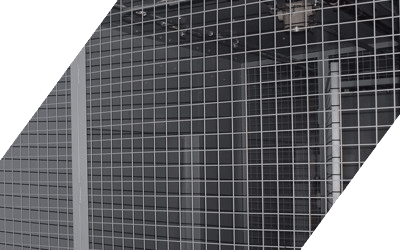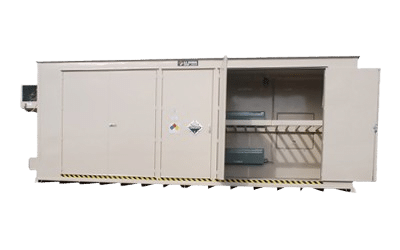Flooring
It is crucial to choose a type of flooring that is right for your chemical inventory. The ideal type depends on the chemical inventory, how often the inventory is moved and the storage containers. We offer a wide variety of customizable flooring options to meet any chemical storage needs.

Types of Flooring
Fiberglass Flooring
Fiberglass floor grating provides effective resistance to corrosive materials. It ensures any hazardous material spill will be safely contained in a sump below the grated floor. This also directs any outside materials that are tracked inside to fall to the below sump for safety precautions.
Fiberglass grating comes in either a t-bar or square molded version.
T-Bar Fiberglass Flooring
Our T-bar fiberglass grating is a non-slip gritted top surface constructed with a wide bar that provides a solid walking area. Made with fire-retardant vinyl ester resin, it is weather-, corrosion- and UV-resistant. This option offers the maximum chemical resistance in floor grating for chemical buildings. Pultruded T-bar grating is impact resistant and comes as a non-conductive option for your hazardous chemical storage needs.
Steel Grating
Galvanized steel floor grating is offered as the standard in all U.S. Chemical Storage Buildings. Heavy-duty steel floor grating is designed to allow chemical leaks or spills to easily fall between the grate into the leak-proof secondary sump containment. Made from strong material and extremely dependable.
Gravity Roller Flooring
Use gravity roller flooring to slide pallets into your chemical storage building with little to no effort, increasing overall efficiency. The smooth, conveyer-type rollers are customized to each individual storage need, allowing you to work with ease and satisfaction.
For more options and to customize your storage flooring, contact our team.
Features & Benefits
- Weather-resistant steel construction
- Chemical & UV resistant coating
- Can be manufactured to meet EPA, NFPA 30 and NFPA 1
- Continuously welded, leak-tested sump
- Walk-in or rack style available
- 15-year structural warranty
Common Applications
- Hazardous Waste Storage
- Flammable and Combustible Storage
- Paint and solvent Storage
Downloadable Information & Fact Sheets
- Drawing: 2-Hour Bi-Direction Fire Rated Building (FL6115)
- Design Your Explosive Storage Magazine
- Warranty on Building & Accessories
- Buy or Build Chemical Storage Brochure
- Infographic: Choosing a Chemical Storage Building
- FireLoc 1-page Sheet
Compliance & Approvals
At U.S. Chemical Storage we strive to give you the best solution for your operations. This building and its accompanying accessories can be engineered to meet the following approvals and certifications based upon your unique set of needs.
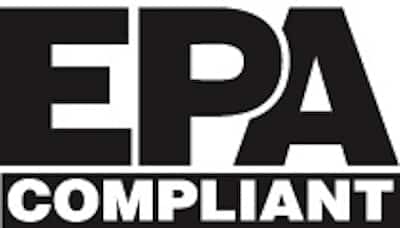
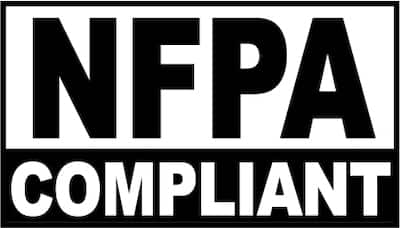


Frequently Asked Questions
First consult the Safety Data Sheet (SDS) to determine the type of chemical you’re storing and any storage requirements listed. There are two main classifications of buildings to consider: fire-rated and non-fire-rated steel buildings.
There are three main questions you should answer before engineering or design can begin on your building: what is to be stored, how much of it is being stored, and where is the location it will be stored? You will also need to consult with your local “Authority Having Jurisdiction” (AHJ) or local code expert to determine your area’s specific storage building requirements.
Our team at U.S. Chemical Storage has a wealth of knowledge, experience, and resources to help analyze your storage needs, but the final approval is made by the local AHJ, so you will need to ultimately ask them about your requirements early in the planning process.
The definition of a “sump” is a pit or reservoir providing containment for spilled liquids. U.S. Chemical Storage offers leak-proof spill containment sumps in each standard model. All our sumps are tested for leaks for a 24-hour period prior to finishing. The sump is then covered by a steel or fiberglass floor grating and can even be equipped with a resistant plastic sump liner to protect against corrosive chemical accidental spills. The size of the sump is dictated by code based on the volume of liquid being stored within the building.
Building size is determined by the amount of hazardous material you are planning to store, the need for occupancy or inspection around these materials, and must take into consideration the most efficient way of moving these materials into and out of your chemical storage building.
Location of the building can be either inside another building or outside to fit your needs. Fire Separation, which is the amount of fire rating required between two occupancies, or the separation distance between those two occupancies, is determined by the type of chemical or hazard being stored, and distances between buildings, egress pathways, or environmental features. To determine the required fire separation, it is best to consult with your local code authority. Inside another building or within 10 feet of another building, you’ll be required to have a 4-hour fire rating. If your hazmat storage building is located at distances 30 feet or greater your building may not be required to have a fire rating at all.

Request a Quote
Other Types of Indoor Accessories
Fire Suppression
Our fully customizable and compliant fire suppression systems and accessories help save lives and costly materials in the event of an emergency.
Gas Sensors and Other Detection Systems
Improving employee safety means stopping problems before they even start. We offer a full line of gas sensors to do just that.
Partition Walls
Segregating chemicals with partition walls allows for the storage of multiple chemicals inside the same chemical storage building.
Racks and Shelves
Let U.S. Chemical Storage help you get organized with a full line of storage racks and shelves to keep your chemicals sorted.
RELATED ARTICLES
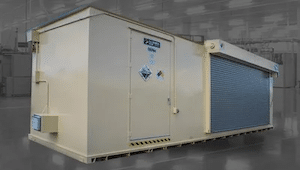
How To Store Lithium Batteries
Lithium batteries are often used in today’s electronic environments.
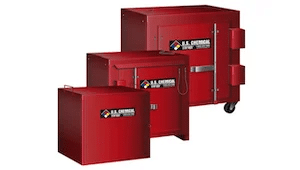
Explosive Storage Magazines
Prevent accidents by storing your high and low explosives properly.

Pharma Hazmat Storage
This manufacturing process needed a compliant 90 day storage solution.




